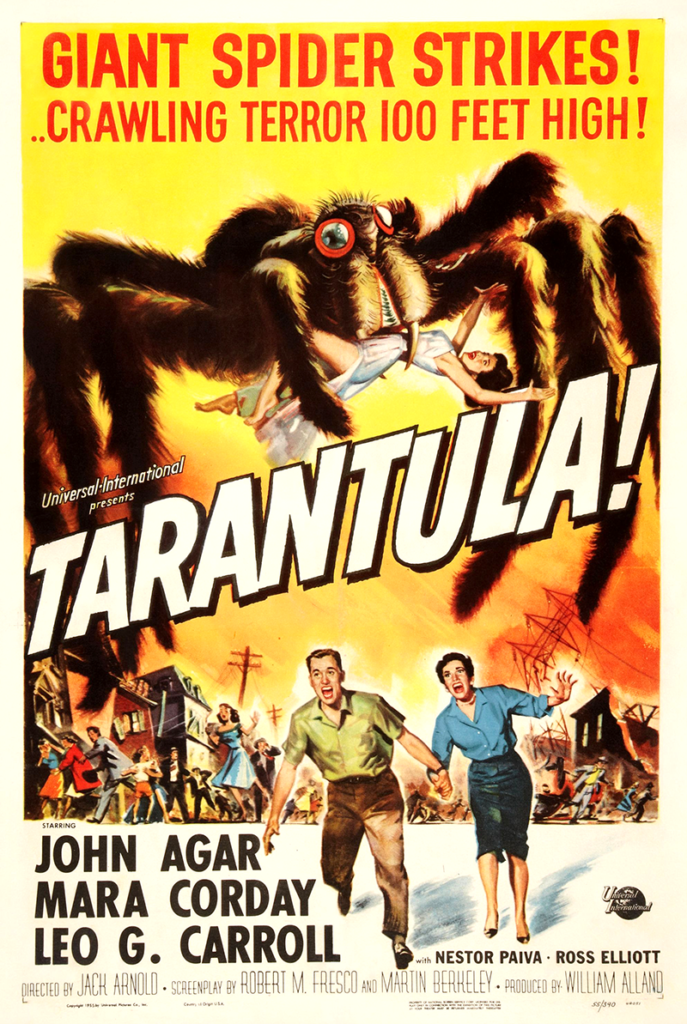For a giant monster flick, there isn’t a whole lot of giant monster in 1955’s Tarantula, the film from director Jack Arnold and screenwriters Robert M. Fresco and Martin Berkeley. An adaptation of a Fresco teleplay for Science Fiction Theatre, the main action in the original plot surrounded the efforts of scientists to develop a synthetic nutrient. Not happy with the progress of the experiments, the scientists tested the nutrient on themselves, with horrific results. I’m not sure of the process involved, but at some point in the mid-1950s, someone involved in the production thought, “Hey, what if we took that TV episode we made a couple of months back, and added a giant tarantula?”
Tarantula follows a formula that, less than a week into this year’s Horrorshow, is already familiar. There’s a rural location somewhere in the American Southwest. Among the hills and desert landscape a new menace has been growing — an animal of oversized proportions, fed on a diet of radiation. After a setup in the first act, the giant monster makes its presence known and terrorizes the local citizenry. What follows is denouement, where the monster is dealt with in a finale that involves explosions and fire. The journey follows a well-worn path. Whether it’s any good is down to the skills of the filmmaker.
The film opens, in a scene that is quite creepy for the time, by showing a severely deformed man dying alone in the desert. This character is a herald for the troubles to come, and it is up to local country doctor Matt Hastings (John Agar and his extraordinary jawline) to find out how this poor fellow died.
The deceased is Eric Jacobs (uncredited). He was one of a pair of scientists working at a lab out in the desert. The other is Professor Gerald Deemer (Leo G. Carroll). The two of them have been developing an experimental nutrient serum and injecting it into lab animals. Jacobs and  an assistant made the rash decision to inject the serum into themselves, the result being a rapid onset of acromegaly, followed by death several days later. So far, this doesn’t have anything to do with a giant spider, but never fear. It will come along eventually.
an assistant made the rash decision to inject the serum into themselves, the result being a rapid onset of acromegaly, followed by death several days later. So far, this doesn’t have anything to do with a giant spider, but never fear. It will come along eventually.
Jacobs is dead, but the lab assistant is still lumbering around the laboratory. In a fit of insanity, he attacks Deemer, causing a fire to break out in the lab. In the confusion, a tarantula about the size of a large dog escapes into the desert. As the plot requires, it soon grows to be the size of a building.
Meanwhile, Hastings is running back and forth in town trying to figure out what killed Jacobs, which we viewers already know. As the film progresses, a new lab assistant arrives. She is Stephanie ‘Steve’ Clayton (Mara Corday), who fulfills the boilerplate role of soft love interest for the main protagonist, and little else.
Astute viewers will notice by this point that this film seems to be about wayward lab experiments more than anything else. This must be a legacy of the original story. And it is an interesting one. The experiments result in a Frankenstein-ish/Hyde transformation in the scientists exposed to the serum, and could have made for a fine standalone film. It makes me wish that there had been a standalone film featuring this plot, and the filmmakers came up with something new for the spider for this movie.
That’s because as intriguing as the lab aspect of the film is, it takes up far too much time in a film that’s ostensibly about a giant spider. It takes about 48 minutes of this film’s 80-minute runtime to finish setting up the plot. By then, there have only been glimpses of the giant spider. I would like to think the lack of spider had to do with raising the film’s tension, but that’s clearly not it. The spider’s absence doesn’t serve to build tension like in Jaws. Rather, it points to a lack of resources, and a general lack of focus in the plot.
When the spider does finally make regular appearances on screen, it doesn’t look that good. Even for the day, the effects are lacking. Composite shots get cropped in the wrong places, and many sequences look to be deliberately underexposed to cover for the effects.
Tarantula is a disappointing film. It takes an existing plot and crams in as little giant monster action as it can to justify the title and make a little money. It fails to expand on the parts that make the plot interesting, and then subjects the audience to substandard effects. Tarantula is an example of how not to make a giant monster film.
